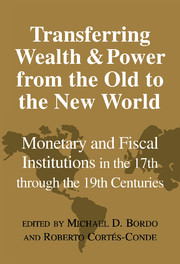 Transferring Wealth and Power from the Old to the New World
Transferring Wealth and Power from the Old to the New World Published online by Cambridge University Press: 27 March 2010
Canada is comprised of 10 provinces and 2 territories whose heritage derives from the (diverse) original peoples of the country and the institutions and cultures of the colonizing powers, as well as those of the equally diverse immigrants. To analyze the impact of imperial traditions on the development of fiscal and monetary institutions throughout the seventeenth to nineteenth centuries would require space and time that we do not have. We therefore focus our discussion on the role of British and French antecedents in the development of Canadian institutions by examining almost exclusively the experiences of Ontario and Quebec, the most populous colonies at the time of Confederation. We will present our data and analysis by breaking down the historical experience into three eras:
1713–63: the French period – New France develops a sustainable economy
1763–1867: the British colony period
1867–1914: the early postcolonial period
In 1713, after the Treaty of Utrecht, the economy along the St. Lawrence River experienced four decades of relatively peaceful development. The fur trading economy diversified with increasing agricultural settlement. Yet the economy also relied heavily on transfers from the imperial government to finance the civil service and the military presence. The population is estimated to have risen steadily from 23,000 in 1713 to the mid 50,000's in 1763 (Desbarats, 1996, 165).
To save this book to your Kindle, first ensure [email protected] is added to your Approved Personal Document E-mail List under your Personal Document Settings on the Manage Your Content and Devices page of your Amazon account. Then enter the ‘name’ part of your Kindle email address below. Find out more about saving to your Kindle.
Note you can select to save to either the @free.kindle.com or @kindle.com variations. ‘@free.kindle.com’ emails are free but can only be saved to your device when it is connected to wi-fi. ‘@kindle.com’ emails can be delivered even when you are not connected to wi-fi, but note that service fees apply.
Find out more about the Kindle Personal Document Service.
To save content items to your account, please confirm that you agree to abide by our usage policies. If this is the first time you use this feature, you will be asked to authorise Cambridge Core to connect with your account. Find out more about saving content to Dropbox.
To save content items to your account, please confirm that you agree to abide by our usage policies. If this is the first time you use this feature, you will be asked to authorise Cambridge Core to connect with your account. Find out more about saving content to Google Drive.